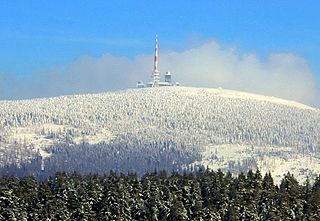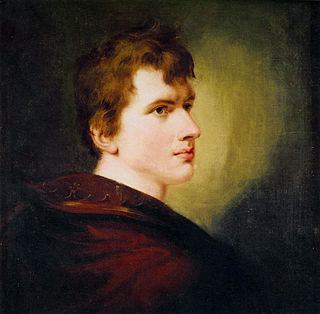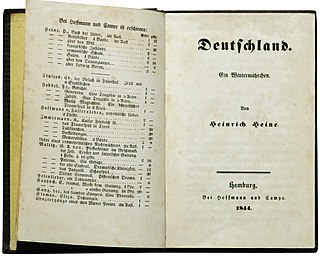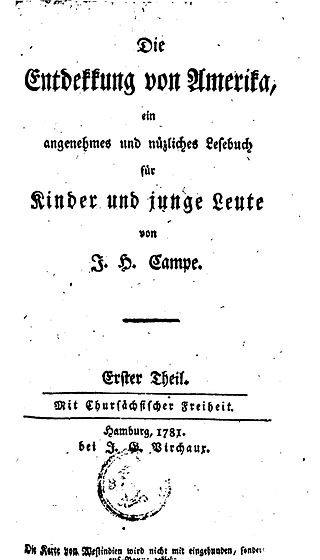
Christian Johann Heinrich Heine was a German poet, writer and literary critic. He is best known outside Germany for his early lyric poetry, which was set to music in the form of Lieder by composers such as Robert Schumann and Franz Schubert. Heine's later verse and prose are distinguished by their satirical wit and irony. He is considered a member of the Young Germany movement. His radical political views led to many of his works being banned by German authorities—which, however, only added to his fame. He spent the last 25 years of his life as an expatriate in Paris.

The Brocken, also sometimes referred to as the Blocksberg, is the highest peak in the Harz mountain range and also the highest peak in Northern Germany; it is near Schierke in the German state of Saxony-Anhalt between the rivers Weser and Elbe. Although its elevation of 1,141 metres (3,743 ft) is below alpine dimensions, its microclimate resembles that of mountains of about 2,000 m (6,600 ft). The peak above the tree line tends to have a snow cover from September to May, and mists and fogs shroud it up to 300 days of the year. The mean annual temperature is only 2.9 °C (37.2 °F). It is the easternmost mountain in northern Germany; travelling east in a straight line, the next prominent elevation would be in the Ural Mountains in Russia.

Carl Joachim Friedrich Ludwig von Arnim, better known as Achim von Arnim, was a German poet, novelist, and together with Clemens Brentano and Joseph von Eichendorff, a leading figure of German Romanticism.

Johann Friedrich Ludwig Hausmann was a German mineralogist.

The Bode is a river in the German state of Saxony-Anhalt, a left tributary of the Saale. It rises in the Harz mountains and drains them in a northerly direction. After 169 kilometres (105 mi) it discharges into the Saale at Nienburg. The river is named after a legendary giant, the wild, rampaging, Bohemian, Prince Bodo, who, according to the Rosstrappe legend, changed into a marauding dog that guarded the crown of Princess Brunhilde in the Kronensumpf in the present-day Bode Gorge. The gorge is the narrow section of the Bode valley between Treseburg and Thale.

Germany. A Winter's Tale is a satirical epic poem by the German writer Heinrich Heine (1797–1856), describing the thoughts of a journey from Paris to Hamburg the author made in winter 1843. The title refers to Shakespeare's Winter's Tale, similar to his poem Atta Troll: Ein Sommernachtstraum, written 1841–46.

The Upper Harz is the northwestern and higher part of the Harz mountain range in Germany. The exact boundaries of this geographical region may be defined differently depending on the context. In its traditional sense, the term Upper Harz covers the area of the seven historical mining towns (Bergstädte) - Clausthal, Zellerfeld, Andreasberg, Altenau, Lautenthal, Wildemann and Grund - in the present-day German federal state of Lower Saxony. Orographically, it comprises the Harz catchment areas of the Söse, Innerste and Grane, Oker and Abzucht mountain streams, all part of the larger Weser watershed.
Christian Ludolf Wienbarg was a German journalist and literary critic, one of the founders of the Young Germany movement during the Vormärz period.
Marie Luise Auguste Petersen was a German author famous for her fairy tale Princess Ilse.

Alfred Meissner was an Austrian poet.

The Ilsestein is a prominent granite rock formation near the town of Ilsenburg in the Harz mountains of central Germany. Offering a scenic view over the Ilse valley to the Brocken massif, the highest mountain of the range, it is today a popular tourist destination.

The Mooskappe is an old, traditional miners head covering. It was intended to protect miners when working underground from the impact of small rockfalls and from hitting their heads against the gallery roof (Firste). The term is German and this type of hat was worn especially in the Harz Mountains of Germany.

The Discovery of America is a trilogy written by the German author and educator Joachim Heinrich Campe (1746–1818). It was originally published in 1781/82 as Die Entdekkung von Amerika – ein angenehmes und nützliches Lesebuch für Kinder und junge Leute and deals with the discovery, early exploration and conquest of America by focusing on one explorer in each volume: Christopher Columbus is treated first, followed by Hernán Cortés and finally Francisco Pizarro. The work is counted among the first books of specific children's literature, directly targeting children and adolescents as its main audience, and Campe is said to have "set the standard for German children's literature." The trilogy is defined by its author's involvement in the German educational movement of philanthropinism and has been a great success, also being translated into several languages.

Karl Friedrich Heinrich Marx was a German physician and college lecturer. Despite sharing the same name, he was not related to Karl Marx, the founder of Marxism.

Fritz Joachim Raddatz was a German feuilletonist, essayist, biographer, journalist and romancier.

"Harzreise im Winter" is a poem by Johann Wolfgang von Goethe, inspired by his ascent of the Brocken in the Harz mountains during the winter of 1777. He reached the summit in the heat of midday, in deep snow, with the landscape below him shrouded in cloud. The Brocken had always been a place of mystery, connected with witches and devils; where illusions such as the Brocken spectre might confuse an unwary traveller, and where few ventured by choice. This was the inspiration and the setting for his poem.

Zur Geschichte der Religion und Philosophie in Deutschland is a three-part essay by Heinrich Heine, each part referred to as a "book". He wrote them in exile in Paris in 1833/34. They were initially published in French, titled De l'Allemagne depuis Luther, in the magazine Revue des deux Mondes in 1834. The first publication in German was as part of Der Salon. Zweiter Band the same year.

Matthias Politycki is a German novelist and poet. He studied in Munich and Vienna and obtained a PhD in philosophy in 1987. His first novel Aus Fälle/Zerlegung des Regenbogens. Ein Entwickelungsroman. appeared that same year. His breakthrough came in 1997 with Weiberroman and in 2008 with his cruise ship satire In 180 Tagen um die Welt.

Hans Heinrich Eduard Vieweg was a German publisher; the owner of Vieweg Verlag.
Friedrich Ludwig Heinrich Waagen also Christian Friedrich Ludwig Heinrich Waagen, Wagen or Wage) was a German portrait, history and landscape painter born in the Holy Roman Empire. Hardly anything is known about his works. However, he had acquired extensive knowledge of art, amassed a collection of paintings in Hamburg and was known to friends with or in-laws of many important personalities of his time. Gustav Friedrich Waagen (1794-1868) and Carl Waagen (1800-1873) are his sons.


















